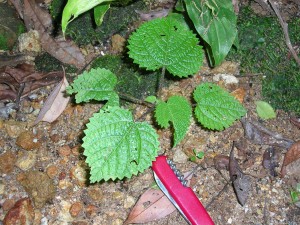Rainforest Hazards
At dusk, the cottages are likely to be visited by coppery brushtail possums and perhaps ringtail possums. They may come right up to you or past you into the cottage looking for food. They are however, WILD ANIMALS and not pets. They also have different personalities. Most are placid and may allow you to stroke them when they are contentedly munching food, but some have been known to bite and scratch if food is not forthcoming, or for no reason at all. Also they have poor eyesight, and cant easily tell where an offered morsel ends and fingers begin.
You may feed them or not as you wish, and a pair of gloves may be found in the chest of drawers in the main living area.
Rangers would advise not feeding them at all, or something that would resemble their natural diet such as fruit and vegies. However, if you run a test on the possums, you will likely find they prefer junk and other human food such as rice and curry followed by cheesecake.
The rainforest is not a hostile environment for people and aborigines used to live in the rainforest until recent times, but there are hazards to be aware of. Foremost is the stinging tree (see picture). Contact with any part of the plant gives a very painful sting which may last for days and sleepless nights. Aches and itches may last up to months later if the limb gets cold. Any clothes, however thin offer complete protection and only bare skin is at risk. To date, only 2 people have come into contact of about 40,000 guests in 29 years.
The stinging tree has microscopic hairs filled with a strong acid that will be delivered direct to the skin nerve endings. The
Spanish Inquisition couldn‘t have thought of anything more diabolical. On the plus side, it is the only thing known to science that can cause extreme pain but produces no tissue damage. For instance a jellyfish sting can produce extreme pain, but also considerable tissue damage and scaring or even death.
It is a native opportunistic quick-growing species that springs up where there is extra light. For instance where a large dead tree has fallen leaving a gap in the canopy, or on the edges of clearings such as roads. It is not usually found in undisturbed rainforest.
It is easy to get lost in the rainforest as directions become confused after walking only a few meters. Guests are advised to keep to the tracks.
The snakes of the rainforest are generally less dangerous than the snakes in the rest of Australia. I have seen only pythons (non-venomous) and black snakes (some venomous and some not). Black snakes are docile and will go to a lot of trouble to avoid you. I have trodden of black snakes half a dozen times and even then, they have never attempted to bite, just escape.
In wet weather, or a few days following, there may be leeches in the rainforest. More near the gullies and less on the ridges. They are small and harmless. Clothes are no protection unless you are wearing a space suit, and only encourage them to climb higher. I simply pick and flick. If you feel in the need of more protection, a spray of insect repellent below the knee does a lot to deter them. If you feel the need for revenge, salt will dehydrate and kill them in 20 secs.
In common with all east coast Oz, there are some ticks. Simply pull out and crush between your thumb nails. If they are too tiny and numerous to remove easily (nymph stage ticks), apply tea-tree oil and leave to die and fall out. I have tea-tree oil at the homestead.
You will be glad to know that mosquitoes are rare at Possum Valley, and sandflies unknown.
